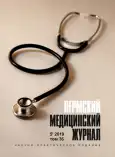Features of formation of biliary dysfunctions in children consuming drinking water with high nitrate content
- Authors: Tolmacheva O.G.1, Ustinova O.Y.2,3, Maklakova O.A.4,5, Ivashova Y.A.6, Vandisheva A.Y.6
-
Affiliations:
- FBIS «Federal Scientific Center for Medical and Preventive Health Risk Management Technologies»
- Federal Scientific Center for Medical and Preventive Health Risk Management Technologie
- Perm State National Research University
- FBIS “Federal Scientific Center for Medical and Preventive Health Risk Management Technologies”
- Perm State National Research University
- Federal Scientific Center for Medical and Preventive Health Risk Management Technologies
- Issue: Vol 36, No 5 (2019)
- Pages: 65-70
- Section: Preventive and social medicine
- URL: https://bakhtiniada.ru/PMJ/article/view/15759
- DOI: https://doi.org/10.17816/pmj36565-70
- ID: 15759
Cite item
Full Text
Abstract
Introduction. In recent years, there is more and more information about the global distribution of nitrates in soil, water, food.
Purpose. To study the features of the formation of biliary dysfunction in children with drinking water with high nitrate content.
Materials. 124 school-age children consuming drinking water with high nitrate content (1.3 MPC) were examined. The comparison group included 52 children living in areas where the nitrate level in drinking water was 4.7 times lower. Results. In children of the observation group, the concentration of N-nitrosodimethylamine in the blood was 3.3 times higher than in the comparison group, and the concentration of nitrates in urine was 1.8 times higher. Every second child with a pathology of the gastrointestinal tract consuming drinking water with a high content of nitrates was diagnosed with biliary dysfunction manifested by hepatocellular dysfunction (increased activity of AST) and a violation of motor-tonic function of the gallbladder by hyperkinetic type against the background of hemolysis of erythrocytes (increased total bilirubin) with a stable level of hemoglobin.
Full Text
##article.viewOnOriginalSite##About the authors
Olga G. Tolmacheva
FBIS «Federal Scientific Center for Medical and Preventive Health Risk Management Technologies»
Author for correspondence.
Email: 70tol@mail.ru
ORCID iD: 0000-0002-1384-8380
PhD, gastroenterologist of the consultative polyclinic department
Russian Federation, 82 Monastyrskaya Str., Perm, 614045Olga Yu. Ustinova
Federal Scientific Center for Medical and Preventive Health Risk Management Technologie; Perm State National Research University
Email: ustinova@fcrisk.ru
ORCID iD: 0000-0002-9916-5491
the doctor of medical sciences, professor, deputy Director for Healthcare Federal Scientific Center for Medical and Preventive Health Risk Management Technologies, Professor of human ecology and safety department
Russian Federation, 614045, Perm, ul.Monastyrskaya, 82; 614990, Perm, str. Bukireva, 15Olga A. Maklakova
FBIS “Federal Scientific Center for Medical and Preventive Health Risk Management Technologies”; Perm State National Research University
Email: olga_mcl@fcrisk.ru
ORCID iD: 0000-0001-9574-9353
PhD, Head of the consultative polyclinic department, Associate Professor of human ecology and safety department
Russian Federation, 614045, Perm, str.Monastyrskaya, 82; 614990, Perm, str. Bukireva, 15Yulia A. Ivashova
Federal Scientific Center for Medical and Preventive Health Risk Management Technologies
Email: ivashova@fcrisk.ru
Head Department of radiation diagnostics
Russian Federation, 614045, Perm, Monastyrskaya str, 82Alexsandra Yu. Vandisheva
Federal Scientific Center for Medical and Preventive Health Risk Management Technologies
Email: vandisheva@fcrisk.ru
ORCID iD: 0000-0003-4180-9394
Head physiotherapy department
Russian Federation, 82 Monastyrskaya Str., Perm, 614045References
- Баранов А.А., Намазова-Баранова Л.С., Альбицкий В.Ю., Терлецкая Р.Н. Состояние здоровья детей современной России. Социальная педиатрия 2018; 20: 120.
- Бастраков С.И., Николаев А.П. Оценка риска качества питьевой воды для здоровья населения. Санитарный врач 2013; 3: 9–10.
- Иванов А.В., Рылова Н.В., Хафизова Г.Н. Роль факторов окружающей среды в формировании патологии пищеварительного тракта у детей. Казанский медицинский журнал 2009; 90 (4): 590.
- Клецкина О.В., Минькевич И.И. Азотное загрязнение подземных вод и управление их качеством в промышленных районах. Вестник Пермского университета 2013; 4: 8–14.
- Кротких Т.А., Михайлова Л.А. Эколого-агрохимические основы применения удобрений в Предуралье: учеб. пособие. Пермь: Изд-во Перм. гос. сельхоз. акад. 2013; 335.
- Крохалева С.И., Черепанова П.В. Содержание нитратов в растительных продуктах и их влияние на здоровье человека. Вестник Приамурского государственного университета им. Шолом-Алейхема 2016; 3: 29–30.
- Салдан И.П. Оценка уровней рисков при воздействии на организм человека нитратного компонента пищевого рациона. Анализ риска здоровью 2018; 4: 82.
- Сыромятников Д.Б. Биохимические нормы в педиатрии: практ. справочник. СПб.: Comuc 1994; 88.
- Сакиев К.З., Батырбекова Л.C. Влияние факторов окружающей среды на состояние гепатобилиарной системы населения, проживающего в экологически неблагоприятных регионах. Медицина и экология 2015; 4: 8.
- Уланова Т.С., Нурисламова Т.В., Мальцева О.А. Газохроматографическое определение высокотоксичных N-нитрозаминов в моче и идентификация методом хромато-масс-спектрометрии. Здоровье населения и среда обитания 2014; 12: 22–24.
Supplementary files






